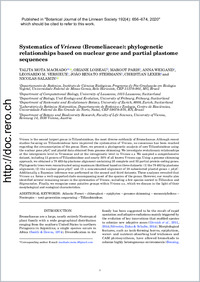Systematics of Vriesea (Bromeliaceae): phylogenetic relationships based on nuclear gene and partial plastome sequences
- Machado, Talita Mota Departamento de Botânica, Instituto de Ciências Biológicas, Programa de Pós-Graduação em Biologia Vegetal, Universidade Federal de Minas Gerais, Belo Horizonte, CEPMG, Brazil
- Loiseau, Oriane Department of Computational Biology, University of Lausanne, Lausanne, Switzerland
- Paris, Margot Department of Biology, Unit Ecology and Evolution, University of Fribourg, Fribourg, Switzerland
- Weigand, Anna Department of Systematic and Evolutionary Botany, University of Zurich, Zurich, Switzerland
- Versieux, Leonardo M Laboratório de Botânica Sistemática, Departamento de Botânica e Zoologia, Centro de Biociências, Universidade Federal do Rio Grande do Norte, Natal, CEP, RN, Brazil
- Stehmann, João Renato Departamento de Botânica, Instituto de Ciências Biológicas, Programa de Pós-Graduação em Biologia Vegetal, Universidade Federal de Minas Gerais, Belo Horizonte, CEPMG, Brazil
- Lexer, Christian Department of Botany and Biodiversity Research, Faculty of Life Sciences, University of Vienna, Vienna, Austria
- Salamin, Nicolas Department of Computational Biology, University of Lausanne, Lausanne, Switzerland
-
27.03.2020
Published in:
- Botanical Journal of the Linnean Society. - 2020, vol. 192, no. 4, p. 656–674
English
Vriesea is the second largest genus in Tillandsioideae, the most diverse subfamily of Bromeliaceae. Although recent studies focusing on Tillandsioideae have improved the systematics of Vriesea, no consensus has been reached regarding the circumscription of the genus. Here, we present a phylogenetic analysis of core Tillandsioideae using the nuclear gene phyC and plastid data obtained from genome skimming. We investigate evolutionary relationships at the intergeneric level in Vrieseeae and at the intrageneric level in Vriesea s.s. We sampled a comprehensive dataset, including 11 genera of Tillandsioideae and nearly 50% of all known Vriesea spp. Using a genome skimming approach, we obtained a 78 483-bp plastome alignment containing 35 complete and 55 partial protein-coding genes. Phylogenetic trees were reconstructed using maximum-likelihood based on three datasets: (1) the 78 483 bp plastome alignment; (2) the nuclear gene phyC and (3) a concatenated alignment of 18 subselected plastid genes + phyC. Additionally, a Bayesian inference was performed on the second and third datasets. These analyses revealed that Vriesea s.s. forms a well-supported clade encompassing most of the species of the genus. However, our results also identified several remaining issues in the systematics of Vriesea, including a few species nested in Tillandsia and Stigmatodon. Finally, we recognize some putative groups within Vriesea s.s., which we discuss in the light of their morphological and ecological characteristics.
- Faculty
- Faculté des sciences et de médecine
- Department
- Département de Biologie
- Language
-
- English
- Classification
- Biological sciences
- License
-
License undefined
- Identifiers
-
- RERO DOC 328594
- DOI 10.1093/botlinnean/boz102
- Persistent URL
- https://folia.unifr.ch/unifr/documents/308627
Other files
Statistics
Document views: 197
File downloads:
- pdf: 1031
- Supplementary material: 211

